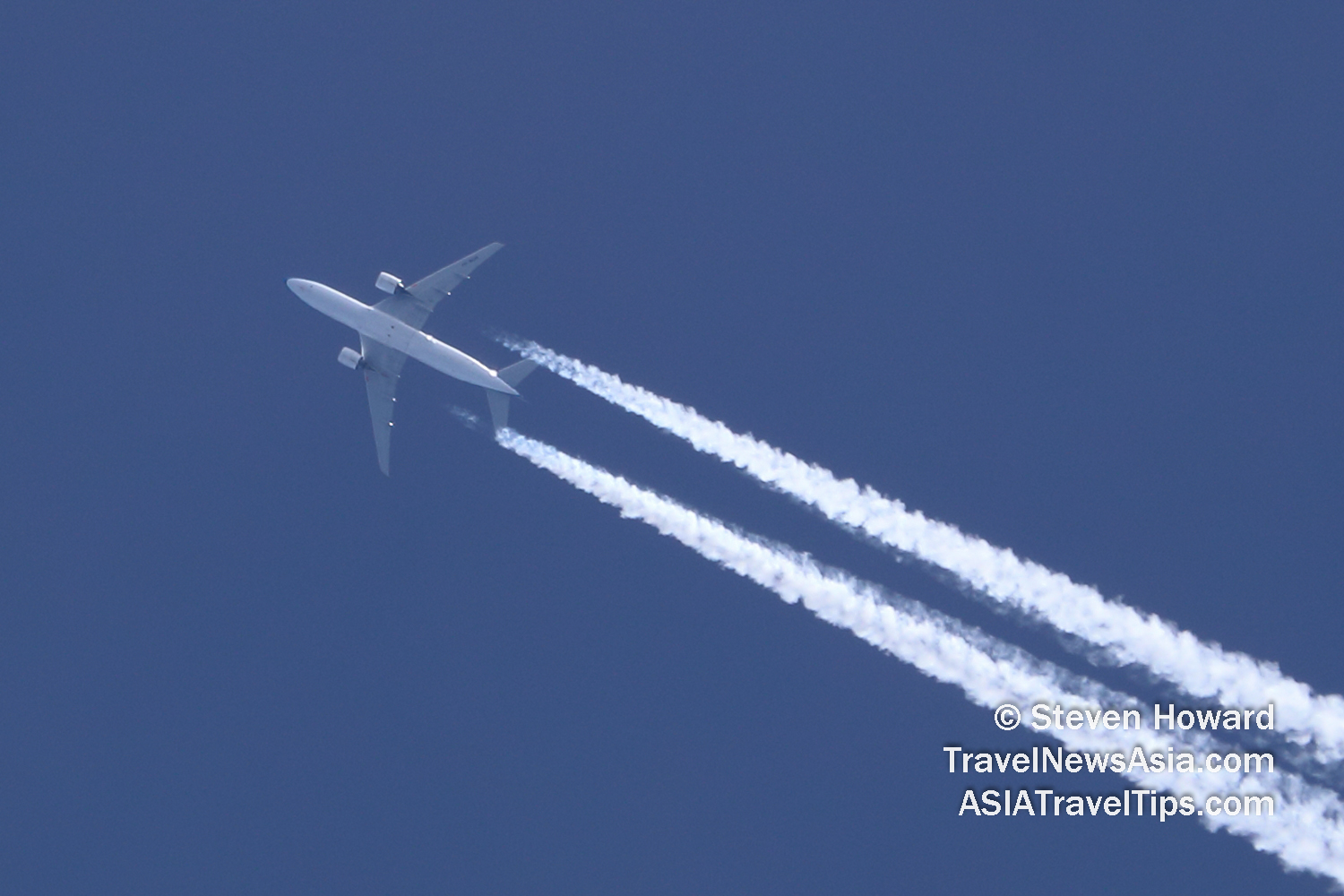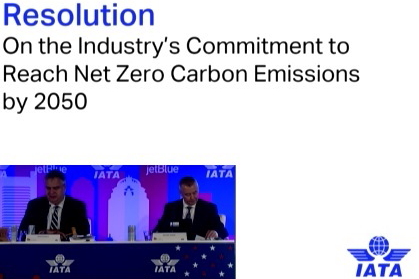|
The gavel came down with a bang at the IATA AGM in
Boston on Monday, and the
resolution for the global air transport industry to achieve
net zero carbon emissions by 2050 was approved, aligning
the sector with the Paris Agreement goal for global warming not to exceed 1.5�C.
�The world�s airlines have taken a momentous decision
to ensure that flying is sustainable,� said Willie Walsh, IATA�s
Director General. �The post-COVID19 re-connect will be on a clear
path towards net zero. That will ensure the freedom of future
generations to sustainably explore, learn, trade, build markets,
appreciate cultures and connect with people the world over. With
the collective efforts of the entire value chain and supportive
government policies, aviation will achieve net zero emissions by
2050.�
Achieving net zero emissions will be a
huge challenge. The aviation industry must progressively reduce
its emissions while accommodating the growing demand of a world
that is eager to fly.

To be able to serve the needs of the ten
billion people expected to fly in 2050, at least 1.8 gigatons of
carbon must be abated in that year. Moreover, the net zero
commitment implies that a cumulative total of 21.2 gigatons of
carbon will be abated between now and 2050.
A key
immediate enabler is the International Civil Aviation
Organization�s (ICAO) Carbon Offsetting and Reduction Scheme for
International Aviation (CORSIA). This will stabilize international
emissions at 2019 levels in the short-to-medium term. Support for
this was reaffirmed in Monday�s resolution.
�Achieving sustainable global connectivity cannot
be accomplished on the backs of airlines alone,� said Walsh. �All
parts of the aviation industry must work together within a
supportive government policy framework to deliver the massive
changes that are needed, including an energy transition. That is
no different than what we are seeing in other industries. Road
transport sustainability efforts, for example, are not being
advanced by drivers building electric vehicles. Governments are
providing policies and financial incentives for infrastructure
providers, manufacturers and car owners to be able to collectively
make the changes needed for a sustainable future. The same should
apply to aviation.�
The strategy is to abate as
much CO2 as possible from in-sector solutions such as sustainable
aviation fuels, new aircraft technology, more efficient operations
and infrastructure, and the development of new zero-emissions
energy sources such as electric and hydrogen power. Any emissions
that cannot be eliminated at source will be eliminated through
out-of-sector options such as carbon capture and storage and credible offsetting schemes.
�We have a plan. The
scale of the industry in 2050 will require the mitigation of 1.8
gigatons of carbon. A potential scenario is that 65% of this will
be abated through sustainable aviation fuels. We would expect new
propulsion technology, such as hydrogen, to take care of another
13%. And efficiency improvements will account for a further 3%.
The remainder could be dealt with through carbon capture and
storage (11% and offsets (8%),� Walsh explained. �The actual split, and the
trajectory to get there, will depend on what solutions are the
most cost-effective at any particular time. Whatever the ultimate
path to net zero will be, it is absolutely true that the only way
to get there will be with the value chain and governments playing
their role.�
The resolution demands
that all industry stakeholders commit to addressing the
environmental impact of their policies, products, and activities
with concrete actions and clear timelines, including:
- Fuel-producing companies bringing large scale,
cost-competitive sustainable aviation fuels (SAF) to the market;
- Governments and air navigation service providers
(ANSPs) eliminating inefficiencies in air traffic management and
airspace infrastructure;
- Aircraft and engine manufacturers producing
radically more efficient airframe and propulsion technologies; and
- Airport operators providing the needed infrastructure to
supply SAF, at cost, and in a cost-effective manner.

The energy transition needed to
achieve net zero must be supported by a holistic government policy
framework focused on realizing cost-effective solutions. This is
particularly true in the area of SAF. Technology exists, but
production incentives are needed to increase supply and lower
costs.
The resolution calls on governments through
ICAO to agree a long-term goal equivalent to the industry�s net
zero by 2050 commitment. In line with the longstanding approach to
managing aviation�s climate change impact, the resolution also
called for governments to support CORSIA, coordinate policy
measures and avoid a patchwork of regional, national, or local
measures.
�Governments must be active partners in
achieving net zero by 2050. As with all other successful energy
transitions, government policies have set the course and blazed a
trail towards success,� Walsh said. �The costs and investment risks are too high
otherwise. The focus must be on reducing carbon. Limiting flying
with retrograde and punitive taxes would stifle investment and
could limit flying to the wealthy. And we have never seen an
environment tax actually fund carbon-reducing activities.
Incentives are the proven way forward. They solve the problem,
create jobs and grow prosperity.�
The combination of measures needed to achieve
net zero emissions for aviation by 2050 will evolve over the
course of the commitment based on the most cost-efficient
technology available at any particular point in time. A base case
scenario as follows is the current focus:
2025: With
appropriate government policy support, SAF production is expected
to reach 7.9 billion liters (2% of total fuel requirement).
2030: SAF production is 23 billion liters (5.2% of total fuel
requirement). ANSPs have fully implemented the ICAO Aviation
System Block Upgrades and regional programs such as the Single
European Sky.
2035: SAF production is 91 billion liters (17%
of total fuel requirement). Electric and/or hydrogen aircraft for
the regional market (50-100 seats, 30-90 min flights) become
available.
2040: SAF production is 229 billion liters (39% of
total fuel requirement). Hydrogen aircraft for the short-haul
market (100-150 seats, 45-120 min flights) become available.
2045: SAF production is 346 billion liters (54% of total fuel
requirement).
2050: SAF production hits 449 billion liters
(65% of total fuel requirement).
�SAF will fuel
the majority of aviation�s global emissions mitigation in 2050.
The recently announced US Grand challenge to increase the supply
of SAF to 11 billion liters (3 billion gallons) by 2030 is a great
example of the kinds of policies that will drive aviation
sustainability. Similarly, the announcements from several big
energy suppliers that they intend to produce billions of extra
liters of SAF in the near term are welcome. But we cannot tolerate
announcements with no follow-up. To be meaningful, fuel suppliers
must be accountable for delivering SAF at cost competitive prices.
�The way forward for all means of carbon
mitigation will be scrutinized. We will match commitments to
achievements in reporting that makes it clear how we are
progressing. Engaging with travelers, environmental NGOs and
governments based on transparent reporting will ensure that our flight path to net zero is fully understood,� said Walsh.
See also:
Rolls-Royce's All-Electric Spirit of Innovation Aircraft Takes Off
for First Time.
See latest
Travel Industry News,
Video
Interviews,
Pictures,
Podcasts
and other
news regarding:
IATA,
SAF,
Sustainable,
Net Zero.
|
Headlines: |
|
|
